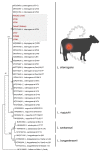Unconventional Sites for Diagnosis of Leptospirosis in Bovine Anicteric Fetuses
- PMID: 37760232
- PMCID: PMC10525537
- DOI: 10.3390/ani13182832
Unconventional Sites for Diagnosis of Leptospirosis in Bovine Anicteric Fetuses
Abstract
Background: Bovine leptospirosis is an important reproductive disease and abortion is a major sign, leading to economic impacts. Due to its multifactorial etiology, the proper diagnosis of the cause of the abortion is crucial. Necropsy of the fetuses followed by molecular analysis is recommended for diagnosis, and the investigation mainly occurs in the kidneys and liver. This study aimed to analyze unconventional sites for the presence of leptospiral DNA in bovine anicteric aborted fetuses.
Methods: Five fetuses of the same herd were received for necropsy and diagnosis. Conventional lipL32-PCR was performed in the fetuses' kidneys, livers, lungs, hearts, spleens, subcapsular kidney content, abomasal fluid, and in the cavity's hemorrhagic contents. To complete the investigation, the sera of 30 cows of the herd were collected to perform the serologic screening by Microscopic Agglutination Test. In addition, six subfertile non-pregnant cows from the same herd were selected due to their low reproductive performance, and genital samples (uterine fragment and cervicovaginal mucus) and urine were collected for lipL32-PCR. PCR-positive samples were submitted to a nested PCR of the secY gene and intended for sequencing.
Results: The herd presented seroreactive animals (11/30, 36.6%), all against the Sejroe serogroup, with titers between 200 and 1600. In necropsy, four fetuses showed hemorrhagic and anicteric lesions, while one fetus had no macroscopic lesions. Regarding molecular analysis, all the fetuses were positive in lipL32-PCR and the positive sites were the heart, lungs, subcapsular kidney content, thymus, kidneys, liver, and abomasal fluid. Only one fetus presented positive results in the kidney and liver, while three fetuses were positive in the abomasal fluid. Five of six cows were positive for lipL32-PCR, all being positive only in genital samples. Of the fetuses and the cows, seven sequences were obtained and all were identified as Leptospira interrogans serogroup Sejroe serovar Hardjoprajitno.
Conclusions: In order to improve the diagnosis of leptospirosis in cows, it is recommended to perform a comprehensive analysis of the samples, beyond the kidneys and liver. Thus, we highly encourage testing multiple organs by PCR to investigate abortions suspected of bovine leptospirosis, particularly in anicteric fetuses.
Keywords: abomasal fluid; abortion; cattle; leptospiral infection; lipL32; molecular analysis; necropsy.
Conflict of interest statement
The authors declare no conflict of interest.
Figures

Similar articles
-
Bovine Genital Leptospirosis: An Update of This Important Reproductive Disease.Animals (Basel). 2024 Jan 20;14(2):322. doi: 10.3390/ani14020322. Animals (Basel). 2024. PMID: 38275782 Free PMC article. Review.
-
Leptospira spp. strains associated with Bovine Genital Leptospirosis (BGL).Microb Pathog. 2022 Dec;173(Pt A):105841. doi: 10.1016/j.micpath.2022.105841. Epub 2022 Oct 27. Microb Pathog. 2022. PMID: 36309182
-
Extra-renal bovine leptospirosis: Molecular characterization of the Leptospira interrogans Sejroe serogroup on the uterus of non-pregnant cows.Vet Microbiol. 2020 Nov;250:108869. doi: 10.1016/j.vetmic.2020.108869. Epub 2020 Sep 29. Vet Microbiol. 2020. PMID: 33010572
-
Detecting Leptospira spp. infection in cows by PCR: What is the best sample to test?Theriogenology. 2025 Jan 1;231:154-159. doi: 10.1016/j.theriogenology.2024.10.020. Epub 2024 Oct 22. Theriogenology. 2025. PMID: 39454480
-
Equine genital leptospirosis: Evidence of an important silent chronic reproductive syndrome.Theriogenology. 2022 Oct 15;192:81-88. doi: 10.1016/j.theriogenology.2022.08.029. Epub 2022 Aug 28. Theriogenology. 2022. PMID: 36063673 Review.
Cited by
-
Comparative genomics of Leptospira santarosai reveals genomic adaptations in bovine genital strains.Front Microbiol. 2025 Jan 7;15:1517151. doi: 10.3389/fmicb.2024.1517151. eCollection 2024. Front Microbiol. 2025. PMID: 39839101 Free PMC article.
-
The Role of Transplacental Infection in Leptospira spp. Epidemiology in Cattle in Caatinga Biome, Brazil.Microorganisms. 2024 May 22;12(6):1044. doi: 10.3390/microorganisms12061044. Microorganisms. 2024. PMID: 38930426 Free PMC article.
-
Bovine Genital Leptospirosis: An Update of This Important Reproductive Disease.Animals (Basel). 2024 Jan 20;14(2):322. doi: 10.3390/ani14020322. Animals (Basel). 2024. PMID: 38275782 Free PMC article. Review.
References
-
- Delooz L., Czaplicki G., Gregoire F., Dal Pozzo F., Pez F., Kodjo A., Saegerman C. Serogroups and genotypes of Leptospira spp. strains from bovine aborted foetuses. Transbound. Emerg. Dis. 2018;65:158–165. - PubMed
-
- Ellis W.A. Animal leptospirosis. Curr. Top. Microbiol. Immunol. 2015;387:99–137. - PubMed
-
- Loureiro A.P., Lilenbaum W. Genital bovine leptospirosis: A new look for an old disease. Theriogenology. 2020;141:41–47. - PubMed
Grants and funding
LinkOut - more resources
Full Text Sources

